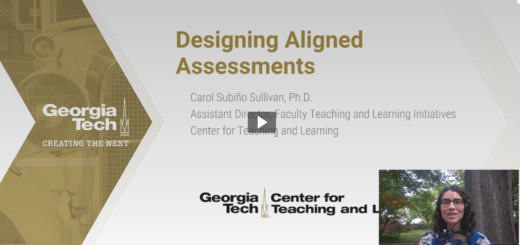Course Design: Beginning with the End in Mind
By Amanda Nolen, Ph.D., Faculty Teaching and Learning Initiatives, Center for Teaching and Learning
When faced with redesigning a course, or designing a course from scratch, instructors are tempted to approach this task in a topic driven manner. In other words, they might first decide what content to teach, how they want to teach that content, then develop assessments around the content, and then finally develop student learning goals.
An alternative approach is the Backward Design Framework defined in Wiggins and McTighe’s Understanding by Design (2005). This approach asks the instructor to begin the design process with the student learning goals first. In starting with the student learning goals, the instructor can define the knowledge and skills the students are expected to master as well as the essential concepts and ideas the students should retain. The second stage of backward design asks the instructor to determine what is the necessary evidence of students’ understanding and learning in achieving the goals. The final stage involves the instructor determining how they will teach the content.

Fig. 1 Backward Course Design Framework (Wiggins & McTighe, 2005) (Image design updated for blog)
By approaching course design from a backward direction, the focus is on student learning outputs instead of on the teaching inputs. This approach has an added benefit of inherent alignment and transparency. The student learning goals become the organizing framework upon which all aspects of the course are connected. They provide guidance for choosing and organizing the course content, developing assessments and course activities, as well as choosing readings and supplementary materials. All course content is provided with a rationale that is grounded in one or more course goals.
This is the guiding framework we use in the Center for Teaching and Learning Course Design Studio. Across four days, we provide a guided and structured journey through the Backward Course Design Framework. Twenty Georgia Tech faculty completed the face-to-face studio in May and we are offering another studio, this time virtual on Zoom, later in July. Each of the four days includes discussion around the principles of course design, time for individual work on their own course, and small group discussion where faculty provide feedback and support for each other’s progress. The studio offers a balance of support and accountability that faculty have found to be helpful in making significant progress in designing a course in a short amount of time.
Registration is still open for the virtual studio offered July 17th, 19th, 24th, and 26th from 9am – noon on Zoom. You can learn more about the studio and reserve your spot here: Course Design Studio | Center for Teaching and Learning (gatech.edu).




